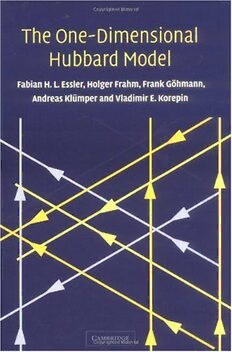Table Of ContentThis page intentionally left blank
THE ONE-DIMENSIONAL HUBBARD MODEL
The description of a solid at a microscopic level is complex, involving the interaction of
a huge number of its constituents, such as ions or electrons. It is impossible to solve the
correspondingmany-bodyproblemsanalyticallyornumerically,althoughmuchinsightcan
be gained from the analysis of simplified models. An important example is the Hubbard
model, which describes interacting electrons in narrow energy bands, and which has been
appliedtoproblemsasdiverseashigh-T superconductivity,bandmagnetismandthemetal-
c
insulatortransition.
Remarkably,theone-dimensionalHubbardmodelcanbesolvedexactlyusingtheBethe
ansatz method. The resulting solution has become a laboratory for theoretical studies of
non-perturbativeeffectsinstronglycorrelatedelectronsystems.Manymethodsdevisedto
analysesucheffectshavebeenappliedtothismodel,bothtoprovidecomplementaryinsight
intowhatisknownfromtheexactsolutionandasanultimatetestoftheirquality.
Thisbookpresentsacoherent,self-containedaccountoftheexactsolutionoftheHubbard
modelinonedimension.Theearlychaptersdevelopaself-containedintroductiontoBethe’s
ansatzanditsapplicationtotheone-dimensionalHubbardmodel,andwillbeaccessibleto
beginninggraduatestudentswithabasicknowledgeofquantummechanicsandstatistical
mechanics. The later chapters address more advanced topics, and are intended as a guide
forresearcherstosomeofthemorerecentscientificresultsinthefieldofintegrablemodels.
The authors are distinguished researchers in the field of condensed matter physics and
integrable systems, and have contributed significantly to the present understanding of the
one-dimensionalHubbardmodel. Fabian Essler isaUniversityLecturerinCondensed
MatterTheoryatOxfordUniversity. Holger Frahm isProfessorofTheoreticalPhysics
at the University of Hannover. Frank Go¨hmann is a Lecturer at Wuppertal University,
Germany. Andreas Klu¨mper isProfessorofTheoreticalPhysicsatWuppertalUniver-
sity. Vladimir Korepin isProfessorattheYangInstituteforTheoreticalPhysics,State
UniversityofNewYorkatStonyBrook,andauthorofQuantumInverseScatteringMethod
andCorrelationFunctions(Cambridge,1993).
THE ONE-DIMENSIONAL
HUBBARD MODEL
FABIAN H. L. ESSLER
OxfordUniversity
HOLGER FRAHM
UniversityofHannover
FRANK GO¨ HMANN
WuppertalUniversity
ANDREAS KLU¨ MPER
WuppertalUniversity
VLADIMIR E. KOREPIN
StateUniversityofNewYorkatStonyBrook
Cambridge, New York, Melbourne, Madrid, Cape Town, Singapore, São Paulo
Cambridge University Press
The Edinburgh Building, Cambridge , UK
Published in the United States of America by Cambridge University Press, New York
www.cambridge.org
Information on this title: www.cambridge.org/9780521802628
© F. H. L. Essler, H. Frahm, F. Göhmann, A. Klümper and V. Korepin 2005
This book is in copyright. Subject to statutory exception and to the provision of
relevant collective licensing agreements, no reproduction of any part may take place
without the written permission of Cambridge University Press.
First published in print format 2005
- ----
eBook (EBL)
- ---
eBook (EBL)
- ----
hardback
- ---
hardback
Cambridge University Press has no responsibility for the persistence or accuracy of
s for external or third-party internet websites referred to in this book, and does not
guarantee that any content on such websites is, or will remain, accurate or appropriate.
Contents
Preface pagexi
1 Introduction 1
1.1 OntheoriginoftheHubbardmodel 1
1.2 TheHubbardmodel–aparadigmincondensedmatterphysics 5
1.3 Externalfields 11
1.4 Conclusions 14
AppendicestoChapter1 15
1.A Responsetoexternalfields 15
2 TheHubbardHamiltoniananditssymmetries 20
2.1 TheHamiltonian 20
2.2 Symmetries 25
2.3 Conclusions 35
AppendicestoChapter2 36
2.A Thestrongcouplinglimit 36
2.B Continuumlimits 45
3 TheBetheansatzsolution 50
3.1 TheHamiltonianinfirstquantization 51
3.2 Solutionofthetwo-particleproblem 54
3.3 Many-particlewavefunctionsandLieb-Wuequations 64
3.4 Symmetrypropertiesofwavefunctionsandstates 67
3.5 Thenormoftheeigenfunctions 68
3.6 Conclusions 72
AppendicestoChapter3 73
3.A Scalarproductsandprojectionoperators 73
3.B DerivationofBetheansatzwavefunctionsandLieb-Wuequations 76
3.C Sometechnicaldetails 94
3.D HighestweightpropertyoftheBetheansatzstateswithrespectto
totalspin 96
3.E ExplicitexpressionsfortheamplitudesintheBetheansatzwave
functions 101
v
vi Contents
3.F Lowestweighttheoremfortheη-pairingsymmetry 105
3.G LimitingcasesoftheBetheansatzsolution 112
4 Stringhypothesis 120
4.1 Stringconfigurations 121
4.2 Stringsolutionsasboundstates 125
4.3 Takahashi’sequations 128
4.4 CompletenessoftheBetheansatz 131
4.5 Higher-levelBetheansatz 133
AppendicestoChapter4 134
4.A Ondeviationsfromthestringhypothesis 134
4.B Detailsabouttheenumerationofeigenstates 137
5 ThermodynamicsintheYang-Yangapproach 149
5.1 Apointofreference:noninteractingelectrons 149
5.2 ThermodynamicBetheAnsatz(TBA)equations 153
5.3 Thermodynamics 161
5.4 Infinitetemperaturelimit 162
5.5 Zerotemperaturelimit 163
AppendicestoChapter5 168
5.A Zerotemperaturelimitforε(cid:2)((cid:3)) 168
1
5.B Propertiesoftheintegralequationsat T = 0 168
6 Groundstatepropertiesinthethermodynamiclimit 175
6.1 Apointofreference:noninteractingelectrons 175
6.2 Definingequations 177
6.3 Groundstatephasediagram 178
6.4 Densityandmagnetization 184
6.5 Spinandchargevelocities 187
6.6 Susceptibilities 188
6.7 Groundstateenergy 193
AppendicestoChapter6 195
6.A Numericalsolutionofintegralequations 195
6.B Groundstatepropertiesinzeromagneticfield 197
6.C Smallmagneticfieldsathalffilling:applicationofthe
Wiener-Hopfmethod 202
7 Excitedstatesatzerotemperature 209
7.1 Apointofreference:noninteractingelectrons 210
7.2 Zeromagneticfieldandhalf-filledband 211
7.3 Rootdensityformalism 225
7.4 Scatteringmatrix 236
7.5 ‘Physical’Betheansatzequations 242
7.6 Finitemagneticfieldandhalf-filledband 244
7.7 Zeromagneticfieldandlessthanhalf-filledband 253
7.8 Finitemagneticfieldandlessthanhalf-filledband 261
7.9 Emptybandintheinfinitevolume 262
Contents vii
AppendicestoChapter7 265
7.A Relatingroot-densityanddressed-energyformalisms 265
7.B Lowerboundsforε (0),n ≥ 2athalffillinginafinitemagneticfield 267
n
8 Finitesizecorrectionsatzerotemperature 268
8.1 Genericcase–therepulsiveHubbardmodelin
amagneticfield 268
8.2 Specialcases 276
8.3 FinitesizespectrumoftheopenHubbardchain 283
8.4 Relationofthedressedchargematrixtoobservables 290
AppendicestoChapter8 294
8.A WienerHopfcalculationofthedressedcharge 294
9 Asymptoticsofcorrelationfunctions 297
9.1 Lowenergyeffectivefieldtheoryatweakcoupling 297
9.2 Conformalfieldtheoryandfinitesizescaling 303
9.3 Correlationfunctionsoftheone-dimensionalHubbardmodel 308
9.4 Correlationfunctionsinmomentumspace 320
9.5 CorrelationfunctionsintheopenboundaryHubbardchain 324
AppendicestoChapter9 331
9.A Singularbehaviourofmomentum-spacecorrelators 331
10 Scalingandcontinuumlimitsathalf-filling 333
10.1 Constructionofthescalinglimit 333
10.2 TheS-matrixinthescalinglimit 335
10.3 Continuumlimit 337
10.4 Correlationfunctionsinthescalinglimit 344
10.5 Correlationfunctionsinthecontinuumlimit 361
10.6 Finitetemperatures 367
AppendicestoChapter10 369
10.A Currentalgebra 369
10.B Two-particleformfactors 371
10.C CorrelationfunctionsintheGaussianmodel 372
11 Universalcorrelationsatlowdensity 376
11.1 TheHubbardmodelinthegasphase 377
11.2 Correlationfunctionsoftheimpenetrableelectrongas 383
11.3 Conclusions 392
12 ThealgebraicapproachtotheHubbardmodel 393
12.1 Introductiontothequantuminversescatteringmethod 393
12.2 Shastry’sR-matrix 411
12.3 Gradedquantuminversescatteringmethod 425
12.4 TheHubbardmodelasafundamentalgradedmodel 440
12.5 Solutionofthequantuminverseproblem 450
12.6 OnthealgebraicBetheansatzfortheHubbardmodel 452
12.7 Conclusions 470
AppendicestoChapter12 472
viii Contents
12.A AproofthatShastry’sR-matrixsatisfiestheYang-Baxterequation 472
12.B Aproofoftheinversionformula 479
12.C Alistofcommutationrelations 484
12.D Someidentitiesneededintheconstructionofthetwo-particle
algebraicBetheansatz-states 484
12.E AnexplicitexpressionforthefermionicR-operator
oftheHubbardmodel 486
13 Thepathintegralapproachtothermodynamics 488
13.1 Thequantumtransfermatrixandintegrability 489
13.2 TheHeisenbergchain 496
13.3 Shastry’smodelasaclassicalanalogueofthe1dHubbardmodel 509
13.4 Diagonalizationofthequantumtransfermatrix 510
13.5 Associatedauxiliaryproblemofdifferencetype 514
13.6 Derivationofnon-linearintegralequations 519
13.7 Integralexpressionfortheeigenvalue 525
13.8 Numericalresults 536
13.9 Analyticalsolutionstotheintegralequations 547
13.10 Conclusions 555
AppendicestoChapter13 557
13.A DerivationofTBAequationsfromfusionHierarchyanalysis 557
13.B Derivationofsingleintegralequation 560
14 TheYangiansymmetryoftheHubbardmodel 563
14.1 Introduction 563
14.2 Thevariable-range-hoppingHamiltonian 564
14.3 ConstructionoftheYangiangenerators 566
14.4 Specialcases 570
14.5 Conclusions 573
AppendicestoChapter14 575
14.A Yangians 575
15 S-matrixandYangiansymmetryintheinfiniteintervallimit 599
15.1 Preliminaries 599
15.2 Passagetotheinfiniteinterval 600
15.3 Yangiansymmetryandcommutingoperators 605
15.4 ConstructingN-particlestates 607
15.5 EigenvaluesofquantumdeterminantandHamiltonian 617
15.6 Conclusions 617
AppendicestoChapter15 618
15.A Someusefulformulae 618
16 Hubbardmodelintheattractivecase 620
16.1 Half-filledcase 622
16.2 Thegroundstateandlowlyingexcitationsbelowhalffilling 625
16.3 Interactionwithmagneticfield 626

